Professional amethyst grading follows the 4Cs: color, clarity, cut, and carat weight. Color ranges from pale lilac to premium deep reddish-purple, while clarity focuses on eye-clean stones with minimal inclusions. Cut quality affects brilliance and light interaction, with precision cuts commanding higher prices. Carat weight pricing remains relatively stable even for larger stones. The GIA provides standardized grading that directly correlates with market value. Understanding these standards will empower your next gemstone purchase.
The 4Cs of Amethyst Evaluation
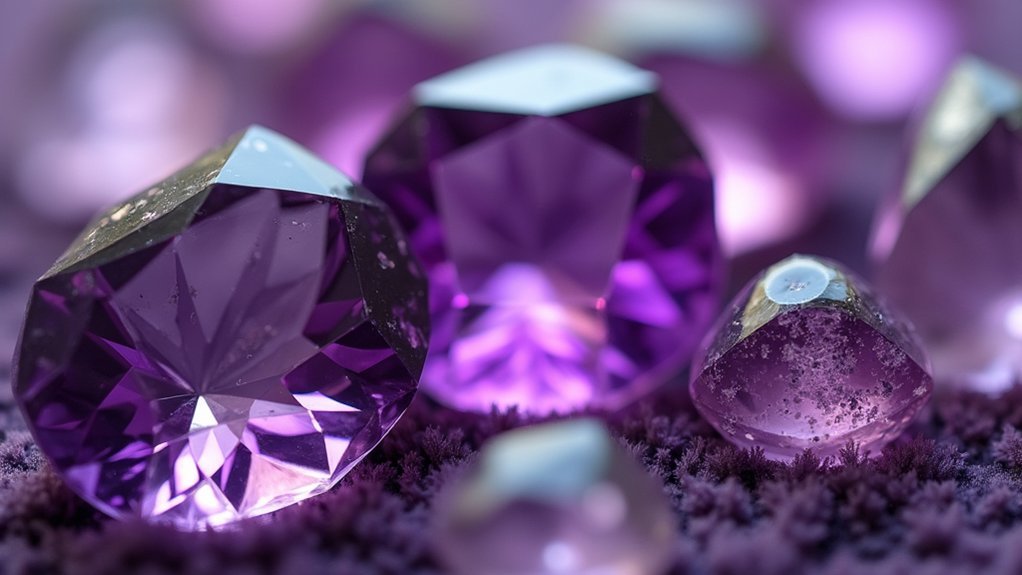
When evaluating amethyst quality, professionals rely on the same fundamental criteria used for diamonds—the 4Cs: Color, Clarity, Cut, and Carat weight. These factors collectively determine a gem’s value and overall quality.
Color is the most significant factor, with premium specimens displaying rich reddish purple or pure purple hues without brownish undertones or color zoning.
When seeking premium amethyst, prioritize stones with deep reddish purple or pure purple coloration, avoiding specimens with brownish tints or uneven color distribution.
For Clarity, you’ll want to look for eye-clean stones free from visible inclusions, as these command higher prices in the market.
The Cut dramatically influences how light interacts with your amethyst, affecting its brilliance and visual appeal. Various facet patterns and shapes can enhance the stone’s natural beauty.
Finally, Carat weight matters, but unlike diamonds, larger amethysts maintain stable per-carat pricing, making them excellent value choices.
Color Assessment: From Pale Lilac to Deep Purple
When you’re evaluating amethyst quality, you’ll need to assess its color across the spectrum from pale lilac to deep purple, with the strongest reddish-purple hues commanding premium values.
You can determine an amethyst’s color quality by examining its hue, tone, and saturation, while watching for value-reducing brownish tints that may be present.
To properly evaluate color zoning, place the stone table-down against a white background, as this technique reveals any inconsistencies that would otherwise diminish the gemstone’s overall grade and value.
Color Assessment: From Pale Lilac to Deep Purple
The spectrum of amethyst color ranges dramatically from delicate lilac to intense deep purple, with the most prized specimens displaying rich reddish-purple hues without any brownish undertones.
When evaluating amethyst quality factors, you’ll want to examine the stone in proper lighting, as darker specimens can appear almost black in dim conditions, considerably reducing their value.
To assess color zoning, place the stone table-down on a white background. Uneven color distribution detracts from both beauty and worth.
The industry values gems exhibiting strong reddish purple or pure purple with consistent saturation throughout. The most valuable AAA-quality amethysts display deep royal purple with distinctive magenta flashes—a rare combination that commands premium prices.
Remember that color grading considers hue, tone, and saturation, with evenly distributed, vibrant colors being most desirable.
Hue Intensity Scale
Gemologists and collectors utilize a standardized hue intensity scale to precisely quantify the color depth of amethyst specimens. When evaluating a stone, you’ll want to place it table-down against a white background to identify any visible color zoning, which greatly reduces value.
| Intensity Level | Color Description | Value Rating |
|---|---|---|
| High (AAA) | Rich reddish-purple | Premium |
| Medium (AA) | Moderate purple | Good |
| Low (A) | Pale lilac | Standard |
The finest amethyst color displays deep, saturated purple with reddish undertones without appearing black in low light. Stones with brownish tints or patchy color distribution command lower prices. Remember that uniform color distribution throughout the stone is essential—even expensive, deep-colored specimens lose value if they exhibit inconsistent coloration across their facets.
Color Zoning Evaluation
Evaluating color zoning represents perhaps the most critical aspect of professional amethyst evaluation, as even specimens with excellent hue can lose significant value from visible banding.
To properly assess this factor in any grading system, examine your stone table-down against a white background where inconsistencies become most apparent.
The finest amethyst displays even color distribution with a strong reddish purple or royal purple color throughout the gem.
You’ll notice that premium specimens lack brownish tints and maintain their vibrant appearance even under varied lighting conditions.
When dark amethyst appears nearly black in low light, its value diminishes considerably.
Remember that while amethyst naturally ranges from pale lilac to deep purple, stones with pure hues, strong saturation, and minimal color zoning command the highest market values.
Clarity Characteristics and Their Impact on Value
When evaluating an amethyst’s overall quality, clarity stands as a critical factor that can greatly impact its market value. Eye-clean specimens—those without visible inclusions—command considerably higher prices in the marketplace than their included counterparts.
While African amethyst, especially from Zambia, may contain more inclusions, it’s often valued for its deep, rich color rather than perfect clarity.
Beauty transcends perfection; Zambian amethyst’s rich purple depths matter more than its clarity.
You’ll find that stones with noticeable inclusions are typically cut as cabochons or beads instead of faceted gems.
- Eye-clean amethyst is premium grade and most desirable for fine jewelry
- Visible inclusions can reduce a stone’s value by 30-50%
- Natural clarity is especially important as fracture-filling treatments are uncommon in amethyst
Cut Quality and Its Effect on Brilliance
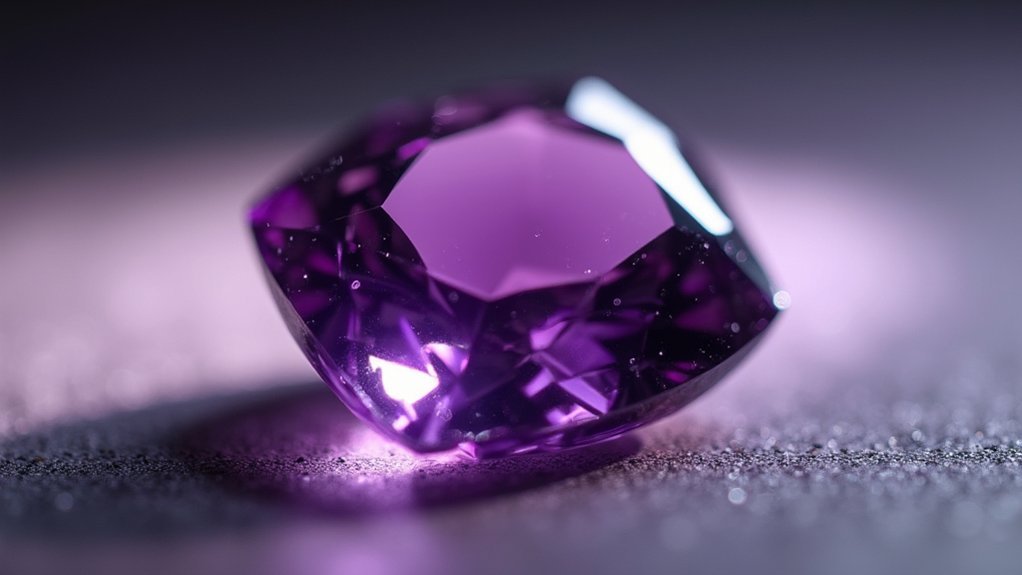
The brilliance of an amethyst largely depends on the quality of its cut, which orchestrates how light travels through the stone. When you’re evaluating colored gemstones like amethyst, you’ll notice that well-executed cuts dramatically enhance the stone’s visual performance.
| Cut Type | Effect on Brilliance |
|---|---|
| Precision Cut | Maximizes light return and color saturation |
| Standard Cut | Provides balanced brilliance and value |
| Shallow Cut | Creates windowing and reduced sparkle |
| Deep Cut | Results in dark areas and diminished vibrancy |
Cut quality affects more than just appearance—it transforms an ordinary amethyst into an extraordinary gem. The symmetry and proportions must be precise; even minor asymmetries can reduce brilliance. While fantasy cuts offer unique appeal, they require exceptional craftsmanship to maintain the stone’s natural brilliance.
Carat Weight Considerations for Amethyst
Unlike many gemstones, you’ll find amethyst’s pricing remains relatively stable as carat weight increases, making larger specimens surprisingly affordable.
This advantageous weight-price ratio means you can select impressive centerpiece amethysts exceeding 22 carats without the exponential cost jumps typical of diamonds or sapphires.
Calibrated cuts in smaller sizes offer excellent color concentration and uniformity, particularly valuable when you’re creating matched sets or multi-stone jewelry pieces.
Weight-Price Ratio Patterns
Amethyst’s unique pricing structure offers collectors a distinct advantage compared to other gemstones. Unlike diamonds or sapphires, amethyst’s price per carat remains relatively stable as size increases, making larger stones an excellent value proposition.
You’ll find that a 22.65-carat amethyst doesn’t command the exponential price increase you’d expect with precious gems.
- Large stones provide dramatic visual impact without breaking your budget
- Smaller, saturated stones offer better options for matched jewelry sets
- Calibrated cuts allow for predictable pricing across standard sizes
When shopping for amethyst, you’re free to prioritize size without the typical financial penalties associated with larger gemstones.
This unique weight-price relationship means you can confidently select stones based on your aesthetic preferences rather than being constrained by dramatic price jumps at specific carat thresholds.
Large Sizes Readily Available
Building on this favorable weight-price relationship, collectors will appreciate that amethyst gems are widely accessible in substantial sizes rarely found in other gemstone varieties.
Unlike many premium gemstones, amethyst offers exceptional value as carat weight increases, with stones over 10 carats maintaining stable per-carat pricing.
You’ll find large gemstones of impressive quality regularly available on the market, with specimens like 22.65 carat cut gems being surprisingly affordable. This accessibility makes amethyst an ideal choice for statement jewelry pieces featuring substantial center stones.
The gemstone’s availability in precisely calibrated cuts guarantees consistent millimeter sizing, simplifying the process of matching stones for sets.
When seeking matched sets, however, you’ll discover that smaller amethysts with strong, rich coloration are typically easier to pair, offering practical options for cohesive jewelry designs.
The GIA Grading System for Amethyst
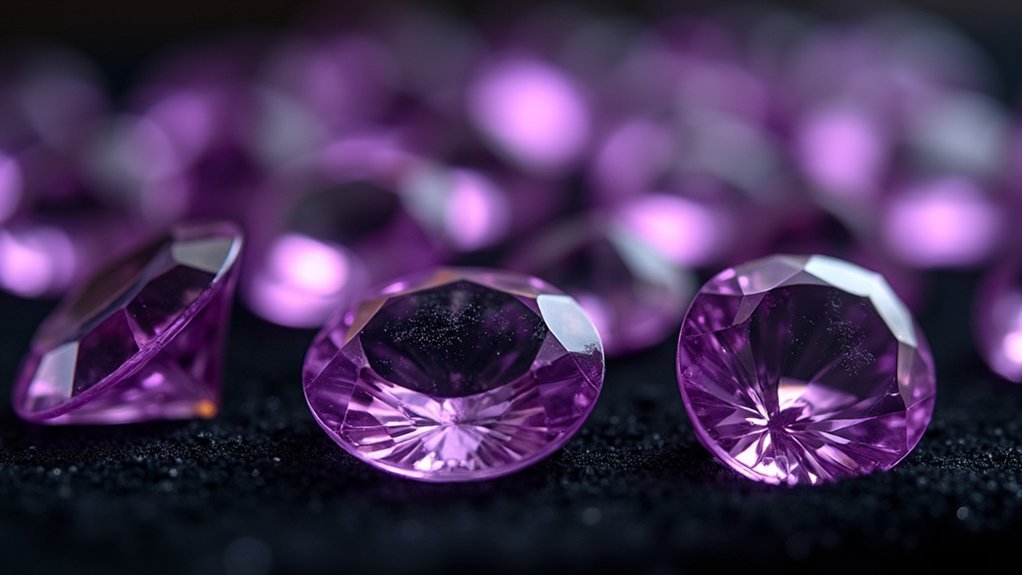
While many gemstones follow strict grading systems, the Gemological Institute of America (GIA) doesn’t maintain a standardized scale specifically for amethyst.
Instead, it evaluates these purple quartz gems based on four key attributes:
- Color – The finest amethysts display strong reddish-purple or pure purple hues without brownish tints or visible color zoning.
- Clarity – High-quality specimens should be “eye-clean” with no visible inclusions.
- Cut – Proper faceting maximizes brilliance and showcases the gem’s color.
When you’re purchasing amethyst, GIA reports provide confirmation of the stone’s natural status and detailed evaluations of these qualities.
While the institute doesn’t assign letter or number grades like it does for diamonds, its thorough assessment gives you reliable information to make informed buying decisions.
Industry Standards vs. Proprietary Grading Scales
Unlike the GIA’s general gemstone reports, you’ll encounter a multitude of grading systems for amethyst, from AGTA’s more standardized approach to countless retailer-specific “A” to “AAA” scales that lack universal definitions.
When comparing amethyst quality across different sellers, you need to understand their specific grading criteria since a stone labeled “AAA” by one dealer might be graded differently elsewhere.
Most reputable dealers use quantifiable metrics like color saturation percentages, inclusion visibility, and cut precision to support their grading claims, though these measurements aren’t consistently applied throughout the industry.
GIA vs. AGTA Methods
When purchasing fine amethyst, you’ll encounter two predominant grading methodologies that greatly impact valuation and purchasing decisions. The GIA employs a standardized, objective approach centered on the four Cs, with color assessment focusing on the ideal strong reddish purple or purple without brownish tints.
Meanwhile, AGTA uses proprietary scales with terms like “AAA” that vary between dealers.
- GIA reports offer universally recognized standards with consistent color grading across all gemstones
- AGTA grading provides additional retail context but lacks standardization between companies
- Understanding both systems helps you make informed decisions when comparing amethyst quality
While GIA’s system delivers objective assessment through standardized criteria, AGTA’s approach may include subjective elements that affect market appeal but don’t guarantee consistent evaluation across the industry.
Quantifiable Quality Metrics
The comparison of GIA and AGTA methods highlights a broader challenge in amethyst evaluation: establishing truly quantifiable quality metrics.
While industry standards consistently emphasize color as the primary value determinant—with rich purple hues commanding premium prices—the actual measurement systems vary considerably between organizations.
You’ll find that clarity assessment follows somewhat more standardized protocols, with most commercial amethyst meeting the “eye-clean” threshold.
However, different grading entities may use varying terminology to describe the same clarity characteristics.
Cut evaluation presents similar challenges, as the assessment of proportions and symmetry lacks universal numeric standards.
This variability means you should always inquire about the specific grading system being used when purchasing fine amethyst, as proprietary scales may emphasize different attributes than standardized GIA or AGTA metrics.
Retailer-Specific Grading Approaches
Despite efforts to standardize amethyst grading across the industry, you’ll encounter considerable variations in how retailers evaluate and market this popular gemstone.
Unlike diamond grading, which follows GIA’s established 4Cs system, colored gems like amethyst often fall victim to subjective evaluations and proprietary scoring methods.
- “AAA-quality” designations appear frequently but carry different meanings depending on the seller.
- Retailer-specific grading approaches often use marketing terms like “Superior,” “Prime,” or “Budget” without universal definitions.
- Personal preferences considerably influence how merchants assess amethyst’s color saturation and clarity.
- Different cutting styles can either minimize or accentuate existing color zoning
- Evaluate stones under various lighting conditions, as dark amethyst may appear black in dim light, concealing zoning issues
- The ideal amethyst displays strong reddish purple coloration with no visible zoning when viewed from any angle
- Heat treatment is common to enhance color, while fracture-filling is rare but must be disclosed
- The Gemological Institute of America offers Colored Stone Identification Reports that verify treatment status
- Many treatments aren’t routinely disclosed, making trusted jewelers with gemological expertise invaluable
When shopping for amethyst, be aware that one jeweler’s “premium” stone might be another’s “standard” quality.
These inconsistencies make it essential to trust your own eyes rather than relying solely on a retailer’s grading terminology.
Origin Influence on Amethyst Quality
While many collectors and dealers emphasize the importance of an amethyst’s geographic origin, you’ll find that a stone’s actual quality characteristics matter far more than its birthplace.
Origin alone doesn’t determine value—inclusions in Zambian amethyst can diminish quality despite the region’s reputation for rich color.
Arizona’s Four Peaks mine produces Superior Grade stones prized for their deep royal purple hue and rarity, setting quality benchmarks regardless of their American origin.
You’ll notice market trends shift, affecting how certain origins are perceived and priced, but experienced buyers focus on quality first.
Brazilian amethysts may yield impressive crystal sizes, but they don’t always match the color saturation of Arizona’s finest specimens.
When evaluating amethyst, prioritize the stone’s intrinsic qualities rather than its geographic pedigree.
Color Zoning Detection and Evaluation
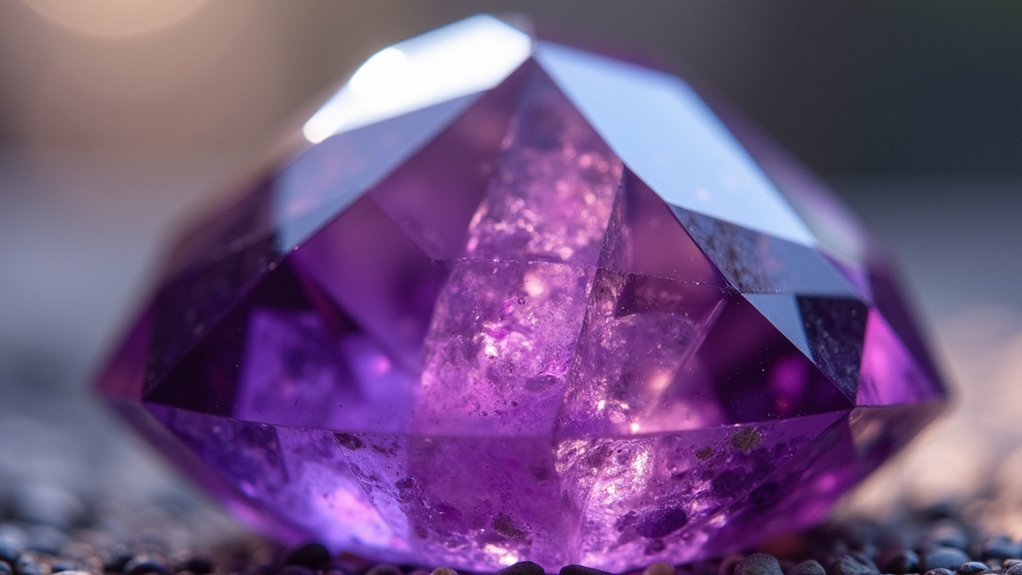
When examining amethyst for color zoning, you’ll need to inspect the stone table-down against a white background, as this method reveals uneven color distribution most effectively.
Professional gemologists use 10x magnification to detect subtle zoning patterns that mightn’t be immediately visible to the naked eye. Color zoning greatly impacts value—stones with uniform coloration command premium prices while eye-visible inclusions and noticeable zoning reduce desirability.
Subtle zoning patterns revealed under magnification can drastically affect an amethyst’s market value and overall desirability.
Remember that even subtle zoning can dramatically affect a stone’s grade and market value in professional assessment.
Inclusion Types Specific to Amethyst
Moving beyond color distribution, the clarity characteristics of amethyst reveal another dimension of quality assessment. As a Type I gemstone, high-quality amethyst is typically eye-clean, meaning inclusions aren’t visible to the naked eye.
When evaluating faceted amethyst, gemologists examine the stone under 10x magnification to identify specific inclusion types. You’ll commonly find gas bubbles, liquid inclusions, and crystalline structures that can impact clarity and value.
African amethyst, particularly Zambian material, often contains more inclusions than other sources, though its rich purple color may compensate for these clarity characteristics.
Stones with noticeable inclusions are generally fashioned as cabochons or beads rather than faceted gems, maximizing their beauty while working around clarity issues that would otherwise diminish their value and appeal.
Treatment Identification in Quality Assessment
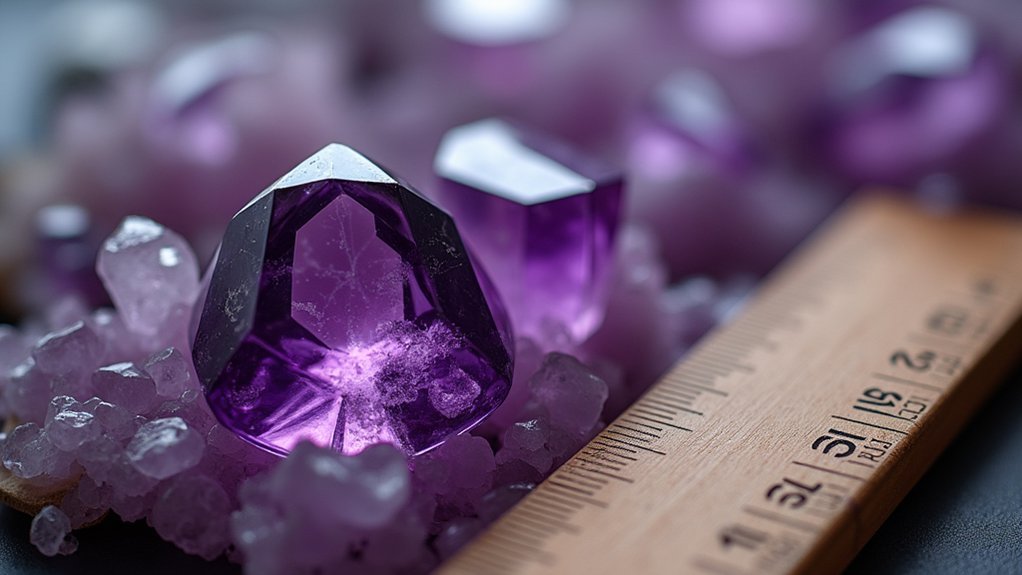
Although amethyst is naturally beautiful, various treatments can enhance its appearance, making treatment identification a critical component of professional grading. Untreated stones generally command higher values in the marketplace, as they represent the gem’s natural state.
When purchasing amethyst, you’ll want confirmation of its treatment status through independent laboratory reports.
Remember that treatments can affect clarity grades and overall value.
Always request transparency about enhancements, as professional quality assessment relies on complete disclosure of any modifications to the natural stone.
Laboratory Certification and Market Value Correlation
Professional laboratory certification directly impacts an amethyst’s market value, serving as an objective verification of the stone’s quality attributes.
When you purchase amethyst with certification from respected laboratories like GIA, you’re paying for verified quality that documents the stone’s color, clarity, cut, and carat weight.
Eye-clean specimens without visible inclusions or color zoning consistently command higher prices, especially when this quality is officially documented.
Flawless amethysts with uniform color distribution deserve their premium prices, particularly with documentation proving their exceptional clarity.
Superior Grade amethysts from prestigious sources like Four Peaks mine achieve premium market value when accompanied by certification confirming their exceptional properties.
The correlation between certification and value is straightforward: certified stones provide confidence in your purchase, ensuring you’re paying a fair market price for authenticated quality rather than relying solely on a seller’s claims.
Frequently Asked Questions
Are There Different Grades of Amethyst?
Yes, there are different grades of amethyst. You’ll find three primary categories: Superior Grade (deepest purple, rare), Prime Grade (vibrant but lighter), and Budget Grade (varies in color quality and clarity).
How to Tell if an Amethyst Is High Quality?
To tell if an amethyst is high quality, you’ll want to check for a deep purple color without brownish tints, guarantee it’s eye-clean with no visible inclusions, and examine the symmetry of its cut.
What Is the Highest Quality Amethyst?
The highest quality amethyst is Superior Grade, featuring deep royal purple color with magenta flashes. You’ll rarely find it over 3 carats, and it represents less than 10% of Arizona Amethyst mined.
How Do You Appraise Amethyst?
To appraise amethyst, you’ll need to evaluate its color (deep purple without brown tints), clarity (fewer inclusions), cut quality (good symmetry and polish), and carat weight. Provenance can also impact value.
In Summary
You’ll find that understanding professional amethyst grading standards empowers you as a collector or investor. By mastering the 4Cs, recognizing color zoning, identifying inclusions, and detecting treatments, you’re equipped to make informed purchases. Remember that laboratory certification provides essential verification of quality. The more you understand these standards, the better you’ll navigate the market and appreciate the true value of your amethyst pieces.

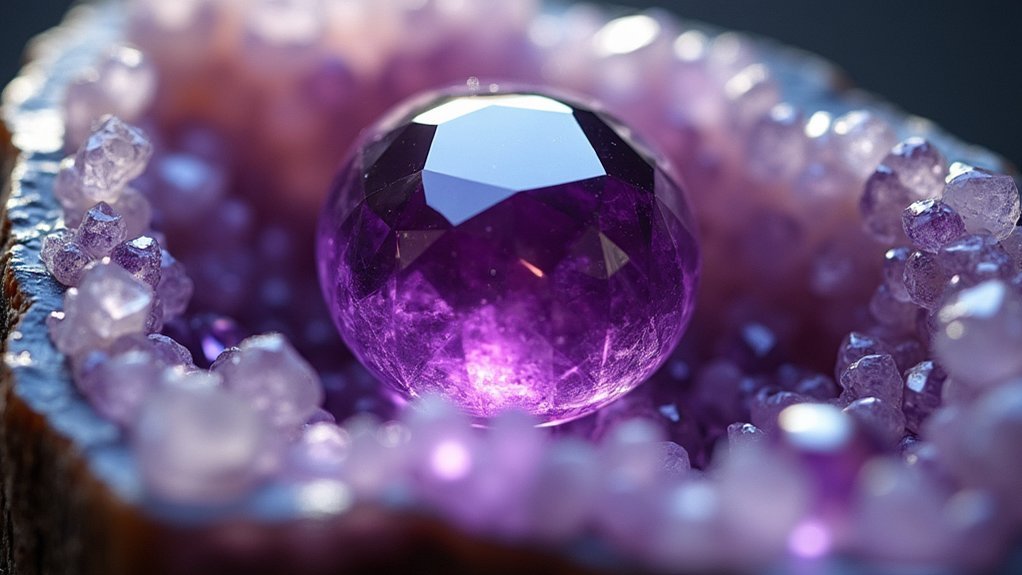



Leave a Reply